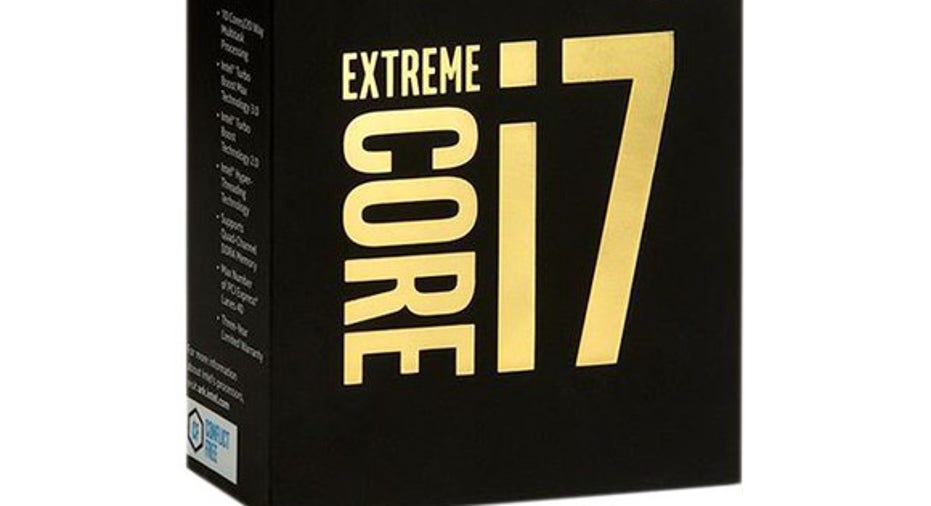The Economics of Intel Corporation's Monster Core i7 6950X

The box that the $1,750 Core i7 6950X comes in. Image source: Intel.
On May 31, microprocessor giant Intel announced a new family of high-end desktop processors formerly code-named Broadwell-E. These chips pack up to 10 Broadwell CPU cores, increasing the maximum core count for the company's high-end desktop lineup from eight to 10. The 10-core part is marketed as the Core i7 6950X.
In this article, I would like to take a look at the relative cost structure of the Broadwell-E parts relative to the prior-generation Haswell-E parts. This should help provide some insight into the gross profit margins of these new parts relative to the outgoing Haswell-E processors.
Looking at the die size
The prior-generation Haswell-E processor family was formed from a single chip: the eight-core Haswell-EP server processor. In its full configuration, it was sold as the $999 Core i7 5960X, with six core variants made out of cut-down versions of that same chip.
That die measured in at 356 square millimeters in Intel's 22-nanometer manufacturing process.
The 10-core Broadwell-E chip is simply the full 10-core Broadwell-EP server chip relabeled and repurposed as a high-end desktop processor. The eight-core model, as well as the two six-core models, are also fashioned out of this same processor.
The size of the die is approximately 246 square millimeters, or approximately 69% the size of the Haswell-E die that it replaces.
Relative cost structure analysis
Intel has indicated in the past that the wafer cost increase, or effectively the cost per area of silicon, was approximately 30% in going from 22-nanometer to 14-nanometer. This means that, all else equal, 246 square millimeters of 14-nanometer silicon should cost about the same as approximately 320 square millimeters of 22-nanometer silicon.
Right off the bat, it would seem that the 10-core Broadwell-E is actually cheaper to manufacture relative to the eight-core Haswell-E.
However, it's important to note that Intel saw a decline in the gross profit margins of its data center business as a result of 14-nanometer yields relative to 22-nanometer yields. To try to get a handle on this, I'm going to try to estimate the die costs for each chip using the following assumptions (using iSine's die yield calculator):
- Broadwell-E: 246 square millimeter die, defect density of 0.2 defects/square centimeter, $9,100 wafer cost.
- Haswell-E: 356 square millimeter die, defect density of 0.1 defects/square centimeter, $7,000 wafer cost.
For the Broadwell-E part, under the above assumptions, 139 of the 223 dies that come off the wafer are good. For the Haswell-E part, of the 153 dies on the wafer, 109 come out good.
Based on this analysis, the raw die cost of the 14-nanometer part should be around $83. The cost of the 22-nanometer part under these assumptions works out to around $64.
Although the numbers that I'm using in this analysis are mainly estimates (Intel does not publish wafer costs or defect densities), I think it's at least reasonable. The point, though, is that if we assume a material yield advantage for the 22-nanometer process over the 14-nanometer process, it's not hard to believe that the 10 core Broadwell-E would be more expensive to build than the 8 core Haswell-E.
Margins? Probably higher
Although when all is said and done, the 6950X is likely to be more expensive to produce than the prior-generation 5960X, Intel is charging around $1,750 for the 6950X, compared to around $1,000 for the 5960X. Gross margins on the 6950X are almost certainly going to be much, much higher than those on the 5960X.
It's worth pointing out, though, that only a small fraction of the PC-buying community is going to buy these chips. However, on the units Intel does sell, the margins should be very high and likely well above corporate average.
The article The Economics of Intel Corporation's Monster Core i7 6950X originally appeared on Fool.com.
Ashraf Eassa owns shares of Intel. The Motley Fool recommends Intel. Try any of our Foolish newsletter services free for 30 days. We Fools may not all hold the same opinions, but we all believe that considering a diverse range of insights makes us better investors. The Motley Fool has a disclosure policy.
Copyright 1995 - 2016 The Motley Fool, LLC. All rights reserved. The Motley Fool has a disclosure policy.